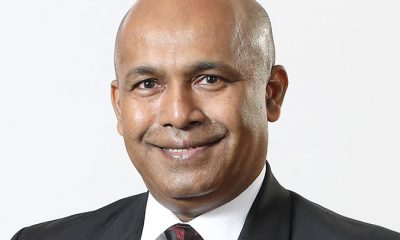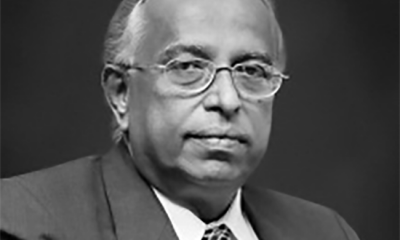Features
Perils to sustained growth

by Dr. G. Usvatte-aratchi
In 2013, Professor A. D. V. de S. Indraratne, the illustrious professor of Economics at Colombo, who was President of the Sri Lanka Economic Association, (they hold the 2023 sessions soon), along with his Committee, was prescient that the fiscal policies of the government might end in disaster and decided to devote the 2013 Sessions to explore ‘perils to sustained growth’ in the economy. The distinguished scholar and diplomat Jayantha Dhanapala was the Guest of Honour. I delivered the Keynote Address. The subject of my lecture was ‘Perils to Sustained Growth’.
Most economists then were troubled by the direction of fiscal and monetary policies at that time. They did not know for certain but were fearful that the massive public works that were undertaken with Chinese loans would not yield the output with which to service those loans. The greater part of the loans was to pay for burgeoning current expenditure. The government would hear none of those and went on with policies of large budget deficits.
A few weeks back, in a press release, the then President and Finance Minister and later Prime Minister of governments, shockingly took credit for reducing the tax revenue of the government year after year. It was shocking because whilst he reduced tax revenue of the government year by year, total government expenditure kept on growing. In a situation where tax revenue comprised more than 98 percent of total revenue of government, rising government expenditure had to be funded at the cost of a rapidly rising debt burden.
The debt from foreign sources had to be serviced with rising export income. Most alarmingly, the proportion of exports to GDP kept falling rapidly. Consequently, a budgetary crisis and a balance of international payments crisis would follow, as the day the night. It precipitated 2021-2022, when a President completely illiterate in economic policy reduced government revenue.
At the same time, he raised the demand for imports with agricultural policies that cut down the domestic food output. The fall in the output of export crops reduced import capacity. Little surprise that in 2022, the government had few choices but to declare bankruptcy.
In my Keynote Address in 2013, I laid bare the sequence of these likely events. I was surprised that policymakers took no notice of the clear warnings presented to them. I was shocked when the then President and Finance Minister, in late 2023, took credit for having actively contributed to that process of decay.
I had laid by that lecture because it was too long and ‘academish’ to be published in The Island, my usual outlet. (Most members of SLEA have higher degrees in economics.) There was no Review in Colombo that may have carried it. It was far too concentrated on Sri Lanka to be published in an international publication. However, after President Mahinda Rajapaksa’s claim, a few days ago, I thought I would seek the advice of the Editor of this newspaper on whether he and his readers would suffer the burden of reading that lecture. With his consent, I decided to publish it.
The text of the speech:
‘And so, we have gone on, and so we will go on, puzzled and prospering beyond example in the history of man.’Thomas Jefferson, 1812.How amazingly right Jefferson was: ‘puzzled and prospering beyond example in the history of man’! Yes, puzzled despite all the ingenuity of all economists since Adam Smith.
The central importance of sustained growth
The economic history of some parts of the world, during the last three hundred years, has been one of phenomenal economic growth. These parts include Europe, North America, Australasia and Japan. In 1,700 all people whether in Africa, Asia, America or Europe were more or less equally poor with a per capita income of about $700 per year at 1985 prices, less than $2 dollars per day. During the next 300 years these economies prospered ‘beyond example in the history of man’.
Much more recently we have had a large part of Asia, including China, Taiwan, India, Malaysia, and South Korea, Thailand and the two small economies of Hong Kong and Singapore grow at phenomenally high rates. In Latin America, after some spectacular growth at the turn of the 20th century, it is only recently that some countries have experienced sustained rapid economic growth. Africa is a late comer and there are signs that sub-Saharan countries finally may have begun to grow.
Sri Lanka has had a record of slow growth, ever since National Accounts began to be estimated but the last few years have shown an upturn in rates of growth. These rates of economic growth shorn of the fluff that the Central Bank tries to cover it with are not to be cavilled at. Your question at this session is how that higher rate of growth can be sustained, at least in the short term.
Let us not underestimate the central importance of fast economic growth to raise levels of living. C. Sivasubramonian (2000), [The National Income of India in the Twentieth Century, The Oxford University Press, New Delhi] estimated that the growth rate of GDP per capita 1901 to 1946-7 in India was 0.9 percent per year and the consequent rise in the GDP per capita was 0.1 percent per year.
At that rate you would have needed 700 years for GDP per capita to double! Contrast that with the experience between 2000-2001 and 2010-2011 when per capita GDP grew at 6.0 percent per annum. [These numbers are from Jean Dreze and Amartya Sen (2013), An uncertain Glory, India and its Contradictions, Princeton University Press, Princeton, NJ]. If that rate of growth were sustained over 35 years, living standards would rise eight times during the lifetime of an individual. However, recently we have seen perils to those high rates of growth.
‘… bang, confidence collapses, lenders disappear, and a crash hits.’
Perils to sustained growth have been studied over a long period of time. In the 20th century itself it was a major field of study. In those times this subject went under the title Trade Cycle. The last volume I remember is Robin Matthews’ ‘The Trade Cycle’ that came out in the year after I graduated. Wesley C. Mitchell’s ‘What Happens during Business Cycles’ had come out beyond the Atlantic much earlier in 1951. The subject is now studied as ‘Crises’, much of that literature coming out in America.
The most recent major study is Reinhart’s and Rogoff’s ‘This Time Is Different’ [2009], in which they studied debt default, whether domestic or foreign, which brought about crises that broke the process of sustained growth. Disruptions to growth arising from such crises are now the major threat to sustained growth, at least in the short and medium terms.
It was Reinhart’s and Rogoff’s conclusion after careful study that ‘… failure to recognize the precariousness and fickleness of confidence, especially in cases in which large short-term debts need to be rolled over continuously, is the key factor that gives rise to the ‘this-time-is-different syndrome’. Highly-indebted governments, banks, corporations or households can seem to be merrily rolling along for an extended period, when bang, confidence collapses, lenders disappear, and a crash hits.’ As you know this happened in the US and Europe in 2007-2008 and it almost took place in India in July-August this year.
The development of crises in the modern sense [the term has a respected longer-term usage] started in the 1970s. President Nixon freed the dollar from the price of gold in 1973. Petroleum exporting countries amassed large volumes of savings looking for financial investment opportunities. So was born the phenomenon of ‘petro-dollars’.
As emerging developing countries grew fast on the strength of exports, they amassed huge surpluses on the external account which formed sovereign wealth funds. The sum of such sovereign funds now probably exceeds $ 15 trillion sufficient to swamp any probable attempt to defend a rate of exchange of a country against adverse movements. And the electronic transfer of funds made it possible to jump from one market to another to profit from even small differences in interest rates, giving a new meaning to D. H. Robertson’s 1926 terms ‘money on wings’. Market opportunities became well known to advisors with the incredibly rapid transfer of information.
With these developments, major economic policies of countries, except those whose currency was acceptable for payment anywhere in the world and those others with huge exchange reserves, found their major domestic policies, ransom to market forces in international capital markets. India with $285 billion in foreign exchange reserves dared not defend the rupee against capital flight in mid-2013. Don’t take seriously the bravado here that $7 billion can do anything to protect the Sri Lanka rupee against even a small shift of short-term capital out of the country.
We spend more than we earn
I have used that extended quotation in the previous but one paragraph because the fundamental problem in our economy is that our economy spends more than it earns [GDP]. That gap is closed with resources from overseas. [This is explained extra-ordinarily well in Arvind Panagariya [2008], India, The Emerging Giant, Oxford University Press, Oxford].
A part of this gap is closed with savings of citizens of this country working overseas and remitting those savings to their home country, with foreign investments directly in the economy, another part with spare resources from accumulated foreign savings if any, and, in its absence, loans from overseas. In our case, in the domestic economy, the private sector does not invest all that it saves.
The government borrows a part of private savings to cover its own expenses. The balance savings it needs are borrowed from overseas. Our economy during the last five years has been accumulating foreign savings by borrowing from abroad, mainly to hedge against fast movements of short-term capital which comprise a part of our national debt. The flow of debt accumulates to form the foreign debt stock of the country. That part of the foreign debt owed by government has been high and fairly stable over the last few years.
To foreign markets and the short end of the market
There has been a marked shift to borrow from overseas and to borrow in the short term. This drive has been motivated by the need to keep interest on government debt in check because interest payments on government debt like all other government expenditure must come out of the Consolidated Fund to which all receipts of government in turn are credited.
Interest rates overseas continue to be lower than at home and interest rates at the short end are usually lower than interest rates at the long end. But these shifts to foreign sources and the short end itself are themselves fraught with serious risks. Any rise in interest rates in other markets shifts money sitting here short term immediately to fly to those other markets. Any loss of confidence in direction of domestic economic policy has the same consequences. To that degree, domestic economic policy is ransom to foreign investors.
Our governments have spent more than they collected in revenue for many years. In 2012, the ratio of total revenue of government to GDP was 13 percent and of total expenditure to GDP 20 percent. The ratio of government revenue to GDP has fallen consistently for several years. There has been some check on the growth of public expenditure, obviously not so severely as to bring down considerably the need to borrow from overseas. In any case, it is hard to make a case for cutting down government expenditure in this economy.
We know too much about the dreadful neglect of education and health in the aggregate and the dire need for reconstruction and development both in the Eastern and Northern Provinces and in the plantations in the central region. There must be immense restraint on the desire of an essentially populist government to control government expenditure in this manner.
Government cannot really cut down expenditure anymore without raising the ire of the public to boiling point. We are too close to what happened in Greece and Spain to risk that. Government must seriously consider why government expenditure on defence and public order and safety must remain at 15 percent of the total both in 2009 and 2012.
It certainly cannot raise government expenditure without first raising government revenue. It is the same populist inclinations which make it hard for government to tax people on whose vote it depends to win elections. Government has taxed heavily consumption of high-income groups. Without taxing the general public, it is in no position to raise revenue to pay for higher expenditure. And a populist government will not do it. That is the point at which long term growth becomes hostage to short term stability.
(To be concluded)
Features
US foreign policy-making enters critical phase as fascist threat heightens globally
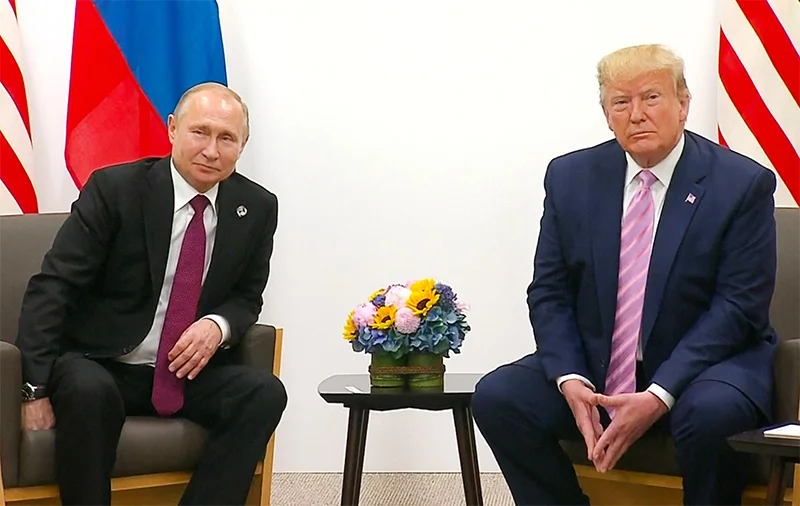
 It could be quite premature to claim that the US has closed ranks completely with the world’s foremost fascist states: Russia, China and North Korea. But there is no denying that the US is breaking with tradition and perceiving commonality of policy orientation with the mentioned authoritarian states of the East rather than with Europe and its major democracies at present.
It could be quite premature to claim that the US has closed ranks completely with the world’s foremost fascist states: Russia, China and North Korea. But there is no denying that the US is breaking with tradition and perceiving commonality of policy orientation with the mentioned authoritarian states of the East rather than with Europe and its major democracies at present.
Increasingly, it is seemingly becoming evident that the common characterization of the US as the ‘world’s mightiest democracy’, could be a gross misnomer. Moreover, the simple fact that the US is refraining from naming Russia as the aggressor in the Russia-Ukraine conflict and its refusal to perceive Ukraine’s sovereignty as having been violated by Russia, proves that US foreign policy is undergoing a substantive overhaul, as it were. In fact, one could not be faulted, given this backdrop, for seeing the US under President Donald Trump as compromising its democratic credentials very substantially.
Yet, it could be far too early to state that in the traditional East-West polarity in world politics, that the US is now squarely and conclusively with the Eastern camp that comprises in the main, China and Russia. At present, the US is adopting an arguably more nuanced approach to foreign policy formulation and the most recent UN Security Council resolution on Ukraine bears this out to a degree. For instance, the UN resolution in question reportedly ‘calls for a rapid end to the war without naming Russia as the aggressor.’
That is, the onus is being placed on only Ukraine to facilitate an end to the war, whereas Russia too has an obligation to do likewise. But it is plain that the US is reflecting an eagerness in such pronouncements to see an end to the Ukraine conflict. It is clearly not for a prolongation of the wasting war. It could be argued that a negotiated settlement is being given a try, despite current international polarizations.
However, the US could act constructively in the crisis by urging Russia as well to ensure an end to the conflict, now that there is some seemingly friendly rapport between Trump and Putin.
However, more fundamentally, if the US does not see Ukraine’s sovereignty as having been violated by Russia as a result of the latter’s invasion, we are having a situation wherein the fundamental tenets of International Law are going unrecognized by the US. That is, international disorder and lawlessness are being winked at by the US.
It follows that, right now, the US is in cahoots with those powers that are acting autocratically and arbitrarily in international politics rather than with the most democratically vibrant states of the West, although a facile lumping together of the US, Russia and China, is yet not possible.
It is primarily up to the US voting public to take clear cognizance of these developments, draw the necessary inferences and to act on them. Right now, nothing substantive could be done by the US voter to put things right, so to speak, since mid-term US elections are due only next year. But there is ample time for the voting public to put the correct perspective on these fast-breaking developments, internationally and domestically, and to put their vote to good use in upcoming polls and such like democratic exercises. They would be acting in the interest of democracy worldwide by doing so.
More specifically it is up to Donald Trump’s Republican voter base to see the damage that is being done by the present administration to the US’ standing as the ‘world’s mightiest democracy’. They need to bring pressure on Trump and his ‘inner cabinet’ to change course and restore the reputation of their country as the foremost democracy. In the absence of such action it is the US citizenry that would face the consequences of Trump’s policy indiscretions.
Meanwhile, the political Opposition in the US too needs to get its act together, so to speak, and pressure the Trump administration into doing what is needed to get the US back to the relevant policy track. Needless to say, the Democratic Party would need to lead from the front in these efforts.
While, in the foreign policy field the US under President Trump could be said to be acting with a degree of ambivalence and ambiguity currently, in the area of domestic policy it is making it all to plain that it intends to traverse a fascistic course. As has been proved over the past two months, white supremacy is being made the cardinal principle of domestic governance.
Trump has made it clear, for example, that his administration would be close to ethnic chauvinists, such as the controversial Ku Klux Klan, and religious extremists. By unceremoniously rolling back the ‘diversity programs’ that have hitherto helped define the political culture of the US, the Trump administration is making no bones of the fact that ethnic reconciliation would not be among the government’s priorities. The steady undermining of USAID and its main programs worldwide is sufficient proof of this. Thus the basis has been adequately established for the flourishing of fascism and authoritarianism.
Yet, the US currently reflects a complex awareness of foreign policy questions despite having the international community wondering whether it is sealing a permanent alliance with the main powers of the East. For instance, President Trump is currently in conversation on matters in the external relations sphere that are proving vital with the West’s principal leaders. For example, he has spoken to President Emmanuel Macron of France and is due to meet Prime Minister Keir Starmer of the UK.
Obviously, the US is aware that it cannot ‘go it alone’ in resolving currently outstanding issues in external relations, such as the Ukraine question. There is a clear recognition that the latter and many more issues require a collaborative approach.
Besides, the Trump administration realizes that it cannot pose as a ‘first among equals’, given the complexities at ground level. It sees that given the collective strength of the rest of the West that a joint approach to problem solving cannot be avoided. This is particularly so in the case of Ukraine.
The most major powers of the West are no ‘pushovers’ and Germany, under a possibly Christian Democratic Union-led alliance in the future, has indicated as much. It has already implied that it would not be playing second fiddle to the US. Accordingly, the US is likely to steer clear of simplistic thinking in the formulation of foreign policy, going forward.
Features
Clean Sri Lanka – hiccups and remedies
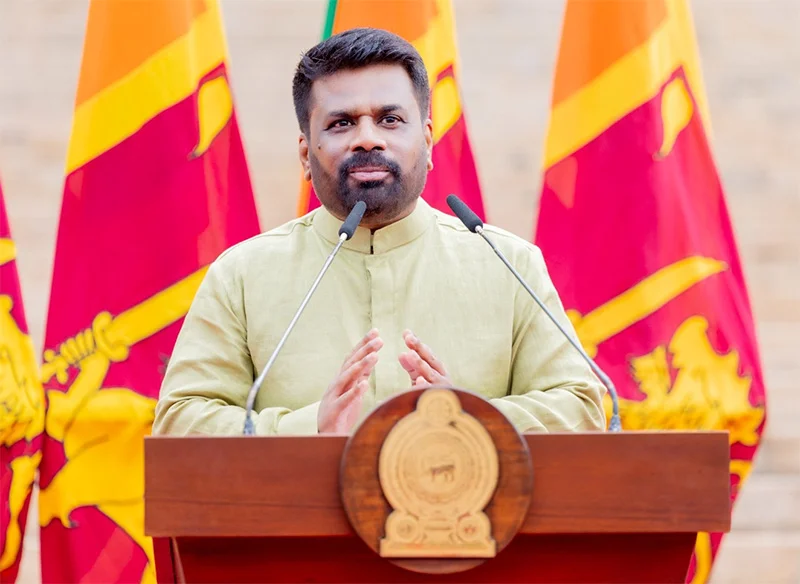
by Upali Gamakumara,
Upali.gamakumara@gmail.com
The Clean Sri Lanka (CSL) is a project for the true renaissance the NPP government launched, the success of which would gain world recognition. It is about more than just cleaning up places. Its broader objectives are to make places attractive and happy for people who visit or use services in the country, focusing more on the services in public institutions and organisations like the SLTB. Unfortunately, these broader objectives are not apparent in its theme, “Clean Sri Lanka,” and therefore there is a misconception that keeping the environment clean is the main focus.
People who realise the said broader objectives are excited about a cleaner Sri Lanka, hoping the President and the government will tackle this, the way they are planning to solve other big problems like the economy and poverty. However, they do not see themselves as part of the solution.
From the management perspective, the CSL has a strategic plan that is not declared in that manner. When looking at the government policies, one can perceive its presence, the vision being “A Prosperous Nation and a Beautiful Life,” the mission “Clean Sri Lanka” and the broader objectives “a disciplined society, effective services, and a cleaner environment.” If the government published these as the strategy, there would have been a better understanding.
Retaining the spirit and expectations and continuing the ‘Clean Sri Lanka’ project is equally important as much as understanding its deep idea. For this, it needs to motivate people, which differs from those motivators that people push to achieve selfish targets. The motivation we need here is to evolve something involuntarily, known as Drivers. Drivers push for the survival of the evolution or development of any entity. We see the absence of apparent Drivers in the CSL project as a weakness that leads to sporadic hiccups and free flow.
Drivers of Evolution
Drivers vary according to the nature of envisaged evolution for progress. However, we suggest that ‘the force that pushes anything to evolve’ would fit all evolutions. Some examples are: ‘Fitting to survival’ was the driver of the evolution of life. Magnetism is a driver for the unprecedented development of physics – young Einstein was driven to enquire about the ‘attraction’ of magnets, eventually making him the greatest scientist of the 20th century.
Leadership is a Driver. It is essential but do not push an evolution continually as they are not sprung within a system involuntarily. This is one of the reasons why CSL has lost the vigour it had at its inception.
CSL is a teamwork. It needs ‘Drives’ for cohesion and to push forward continually, like the Quality Improvement Project of the National Health Service (NHS) in England. Their drivers are outlined differently keeping Aims as their top driver and saying: Aims should be specific and measurable, not merely to “improve” or “reduce,” engage stakeholders to define the aim of the improvement project and a clear aim to identify outcome measures.
So, we think that CSL needs Aims as defined by NHS, built by stakeholder participation to help refine the project for continuous evolution. This approach is similar to Deming’s Cycle for continual improvement. Further, two more important drivers are needed for the CSL project. That is Attitudinal Change and Punishment. We shall discuss these in detail under Psychoactive Environment (pSE) below.
Aside from the above, Competition is another driver in the business world. This helps achieve CSL objectives in the private sector. We can see how this Driver pushes, with the spread of the Supermarket chains, the evolution of small and medium retail shops to supermarket level, and in the private banks and hospitals, achieving broader objectives of CSL; a cleaner environment, disciplined behaviuor, efficient service, and the instillation of ethics.
The readers can now understand the importance of Drivers pushing any project.
Three Types of Entities and Their Drives
We understand, that to do the transformation that CSL expects, we need to identify or adopt the drivers separately to suit the three types of entities we have in the country.
Type I entities are the independent entities that struggle for their existence and force them to adopt drivers involuntarily. They are private sector entities, and their drivers are the commitment of leadership and competition. These drivers spring up involuntarily within the entity.
Type II are the dependent entities. To spring up drivers of these entities commitment of an appointed trustee is a must. Mostly in state-owned entities, categorized as Boards, Authorities, Cooperations, and the like. Their drivers do not spring up within or involuntarily unless the leader initiates. The Government of a country also falls into this type and the emergence of drivers depends on the leader.
Type III entities have neither independent nor dependent immediate leader or trustee. They are mostly the so-called ‘Public’ places like public-toilets, public-playgrounds, and public-beaches. No team can be formed as these places are open to any, like no-man-land. Achieving CSL objectives at these entities depends on the discipline of the public or the users.
Clean Sri Lanka suffers the absence of drivers in the second and third types of entities, as the appointed persons are not trustees but temporary custodians.
The writer proposes a remedy to the last two types of entities based on the theory of pSE explained below.
Psychoactive Environment (pSE) –
The Power of Customer Attraction
Research by the writer introduced the Psychoactive Environment (pSE) concept to explain why some businesses attract more customers than others who provide the same service. Presented at the 5th Global Conference on Business and Economics at Cambridge University in 2006, the study revealed that a “vibe” influences customer attraction. This vibe, termed pSE, depends on Three Distinct Elements, which can either attract or repel customers. A positive pSE makes a business more attractive and welcoming. This concept can help develop Drivers for Type II and III entities.
pSE is not an all-inclusive solution for CSL, but it lays the foundation for building Drivers and motivating entities to keep entrants attractive and contented.
The structure of the pSE
The three distinct Elements are the Occupants, Systems, and Environment responsible for making a pSE attractive to any entity, be it a person, institution, organization, or county. Each of these elements bears three qualities named Captivators. These captivators are, in simple terms, Intelligent, Nice, and Active in their adjective forms.
pSE theorizes that if any element fails to captivate the entrant’s mood by not being Intelligent, Nice, or Active, the pSE becomes negative, repelling the entrant (customer). Conversely, the positive pSE attracts the entrants if the elements are Intelligent, Nice, and Active.
For example, think person who comes to a Government Office for some service. He sees that the employees, service, and environment are intelligent, nice, and active, and he will be delighted and contented. He will not get frustrated or have any deterioration in national productivity.
The Significance of pSE in CSL
The Elements and the Captivators are universal for any entity. Any entity can easily find its path to Evolution or Progress determined by these elements and captivators. The intangible broader objectives can be downsised to manageable targets by pSE. Achievements of these targets make the entrants happy and enhance productivity – the expectation of Clean Sri Lanka (CSL).
From the perspective of pSE, now we can redefine the Clean Sri Lanka project thus:
To make the Elements of every entity in Sri Lanka: intelligent, Nice, and Active.
How Would the pSE be A Remedy for The Sporadic Hiccups?
We have seen two possible reasons for sporadic setbacks and the discontinuity of some projects launched by the CSL. They are:
The absence of involuntary Drivers for evolvement or progress
Poor attitudes and behaviors of people and leaders
Remedy for the Absence of Drivers
Setting up a system to measure customer or beneficiary satisfaction, and setting aims can build Drivers. The East London NHS principles help build the Aims that drive type II & II entities. The system must be designed to ensure continual improvement following the Deming Cycle. This strategy will create Drivers for Type I & II entities.
This process is too long to explain here therefore we refrain from detailing.
Attitudinal Change
The most difficult task is the attitudinal and behavioural change. Yet it cannot be postponed.
Punishment as a strategy
In developed countries, we see that people are much more disciplined than in the developing countries. We in developing countries, give credit to their superior culture, mitigating ours as rudimental. The long experience and looking at this affair from a vantage point, one will understand it is not the absolute truth. Their ruthless wars in the past, rules, and severe punishment are the reasons behind this discipline. For example, anyone who fails to wear a car seatbelt properly will be fined 400 AUD, nearly 80,000 LKR!
The lesson we can learn is, that in Sri Lanka, we need strong laws and strict punishment together with a type of strategic education as follows.
Psychological Approach as a Strategy
The psychological theory of attitude formation can be used successfully if some good programmes can be designed.
All attitude formations start with life experience. Formed wrong or negative attitudes can be reversed or instilled with correct attitudes by exposure to designed life experiences. The programmes have been developed using the concepts of Hoshin Kanri, Brainstorming, Cause-and-Effect analysis, and Teamwork, in addition to London NTS Quality Improvement strategies.
The experience and good responses we received for our pSE programs conducted at several institutions prove and have built confidence in our approach. However, it was a time, when governments or organisations did not pay much attention to cultural change as CSL expects in the country.
Therefore, we believe this is a golden opportunity to take the CSL supported by the pSE concept.
Features
Visually impaired but ready to do it their way
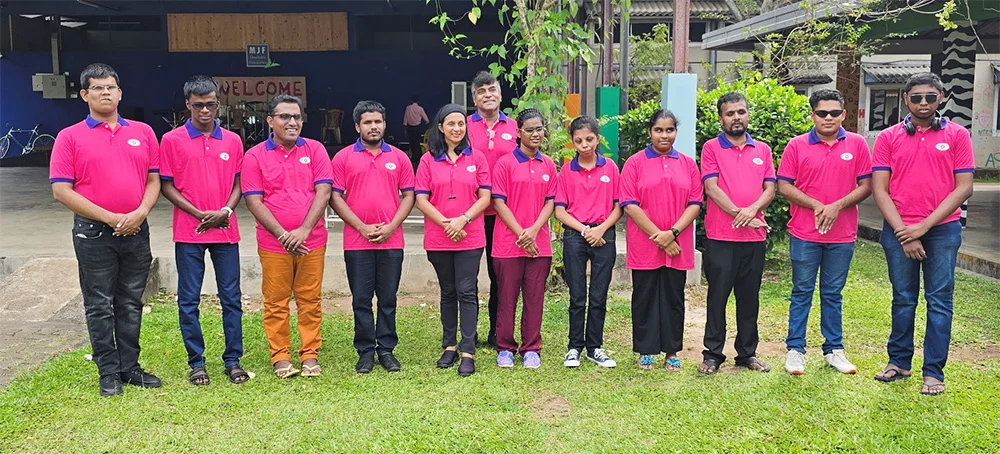
 Although they are visually impaired youngsters, under the guidance of renowned musician Melantha Perera, these talented individuals do shine bright … hence the name Bright Light.
Although they are visually impaired youngsters, under the guidance of renowned musician Melantha Perera, these talented individuals do shine bright … hence the name Bright Light.
Says Melantha: “My primary mission is to nurture their talent and ensure their sustainable growth in music, and I’m thrilled to announce that Bright Light’s first public performance is scheduled for 7th June, 2025. The venue will be the MJF Centre Auditorium in Katubadda, Moratuwa.”
Melantha went on to say that two years of teaching, online, visually impaired youngsters, from various parts of the island, wasn’t an easy ride.
There were many ups and downs but Melantha’s determination has paid off with the forming of Bright Light, and now they are gearing up to go on stage.
According to Melantha, they have come a long way in music.
“For the past few months, we have been meeting, physically, where I guide them to play as a band and now they show a very keen interest as they are getting to the depth of it. They were not exposed to English songs, but I’ve added a few English songs to widen their repertoire.
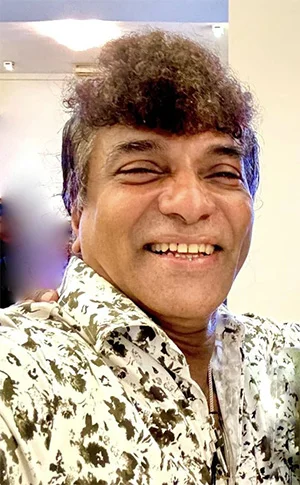
Melantha Perera: Invented a notation
system for the guitar
“On 7th June, we are opening up for the public to come and witness their talents, and I want to take this product island-wide, giving the message that we can do it, and I’m hoping to create a database so there will be a following. Initially, we would like your support by attending the show.”
Melantha says he didn’t know what he was getting into but he had confidence teaching anyone music since he has been in the scene for the past 45 years. He began teaching in 2015,
“When I opened my music school, Riversheen School of Music, the most challenging part of teaching was correcting tone deaf which is the theoretical term for those who can’t pitch a note, and also teaching students to keep timing while they sang and played.”
Melantha has even invented a notation system for the guitar which he has named ‘MelaNota’. He has received copyrights from the USA and ISO from Australia, but is yet to be recognised in Sri Lanka.
During Covid-19, Melantha showcased MelaNota online and then it was officially launched with the late Desmond De Silva playing one of his tunes, using MelaNota.
Melantha says that anyone, including the visually impaired, can play a simple melody on a guitar, within five minutes, using his notation system.
“I’ve completed the system and I’m now finalising the syllabus for the notation system.”
Melantha has written not only for the guitar, but also for drums, keyboards, and wind instruments.
For any queries, or additional information, you could contact Melantha at 071 454 4092 or via email at thebandbrightlight@gmail.com.
-

 Business3 days ago
Business3 days agoSri Lanka’s 1st Culinary Studio opened by The Hungryislander
-

 Sports4 days ago
Sports4 days agoHow Sri Lanka fumbled their Champions Trophy spot
-

 News6 days ago
News6 days agoKiller made three overseas calls while fleeing
-
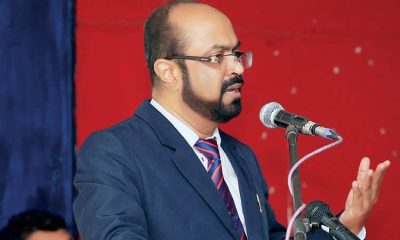
 News5 days ago
News5 days agoSC notices Power Minister and several others over FR petition alleging govt. set to incur loss exceeding Rs 3bn due to irregular tender
-

 Features4 days ago
Features4 days agoThe Murder of a Journalist
-
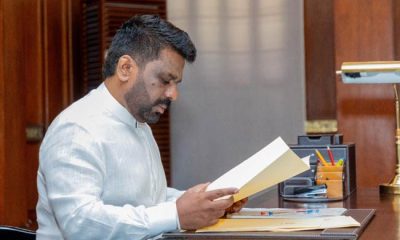
 Features4 days ago
Features4 days agoExcellent Budget by AKD, NPP Inexperience is the Government’s Enemy
-
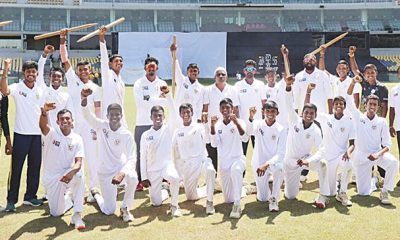
 Sports4 days ago
Sports4 days agoMahinda earn long awaited Tier ‘A’ promotion
-

 News5 days ago
News5 days agoMobile number portability to be introduced in June


